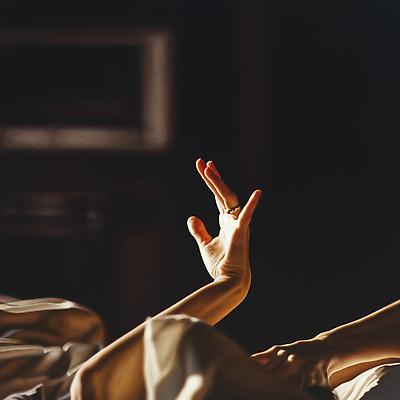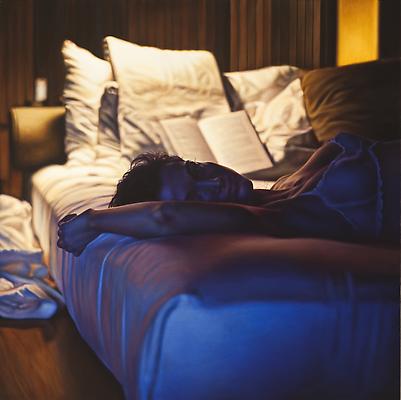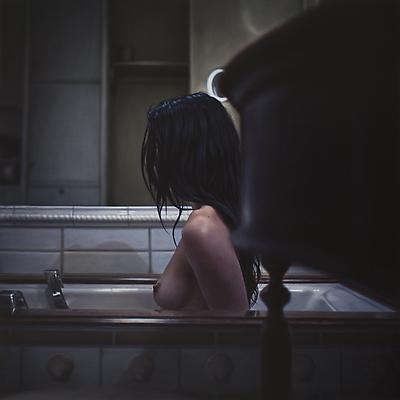Damian Loeb:
Verschränkung and The Uncertainty Principle
May 6 - June 17, 2011Oil on linen, 36 x 36 inches
Oil on linen, 48 x 48 inches
Oil on linen, 36 x 36 inches
Press Release
Damian Loeb:
Verschränkung and The Uncertainty Principle
May 6 - June 17, 2011Acquavella to exhibit Damian Loeb: Verschränkung and The Uncertainty Principle
May 6th through June 17th 2011
New York, NY (May 6th through June 17th) --- Acquavella Galleries is pleased to announce an exhibition of new work by American artist Damian Loeb, Verschränkung and the Uncertainty Principle from May 6th through June 17th 2011. The show's title refers to a term used to explain a paradox of quantum physics wherein subject and object were rendered indistinguishable (Verschränkung) and that the act of observation affects the object being observed (the Uncertainty Principle). Loeb uses this theory as a metaphor to examine the false barrier of safety imagined by observers and their culpable connection to the objects being scrutinized. The exhibition examines the inseparable connection between subject and object, model and artist and posits that voyeurism is not one sided or passive but an active relationship connecting the image and viewer.
Loeb’s new paintings are based on a series of photographs he took of his wife Zoya over the past 7 years, depicting her in moments of quiet calm. She is seen nude or in states of undress, and yet seemingly comfortable in the (imagined) presence of her husband. The images reveal the intimate moments of a life's narrative, exposing both the anticlimactic and the revelatory nature of privacy. Loeb uses his established visual language, sampled liberally from both popular culture, cinematography and art history, to create a constant yet subtle tension throughout the body of work. It is this silent melodrama and Zoya’s constant presence that defines the series more than any individual action or mood portrayed in the paintings.
Among the highlights of the exhibition are the sound of music and atmosphere. In the sound of music Zoya is seen spot-lit, standing nude, holding a phone to her ear and distracted as if looking for the source of an unidentified sound. The specific pose and angle suggest that the viewer is a possible source of her concern; the viewer’s presence as observer creates instantly the intangible, transitional moment when the nude becomes the naked. atmosphere depicts the essence of disorientation: waking up in bright sunlight. The universally familiar moment hints at the subject's inevitable attempts to focus, rub their eyes, and take in their immediate surroundings. The pose of the hand and the sharp contrast of the bright foreground to the dark undefined background highlight the rapidly disappearing safety and solitude of sleep; while the close composition, angle of view and shallow depth of field imply an almost too intimate proximity for a voyeur, creating a creeping tension.
In say hello to the angels, Loeb turns the tables. In this painting is the viewer who is suddenly in an exposed position, being in the subject's direct line of view. Zoya’s face, backlit and through the blue glow of a television, slowly appears in the shadows, revealing a glassy, inscrutable stare that implies more that the viewer is the object being seen through than being seen.
Loeb implements classic representational painting techniques, a mix of historic compositions, and the contemporary narrative tropes of cinema as tools to guide - or misdirect - the viewer. Despite the fact that the final image takes months to produce, Loeb creates the possibility that these scenes are actually spontaneous, vulnerable and real, reluctantly giving away that which is most precious: the intimacy of privacy. The artist explains, “I know a piece is finished when I am invisible and the moment is everything.”
Damian Loeb (b. 1970) dropped out of high school to pursue painting full time. He was quickly discovered by gallerist and current MOCA director Jeffrey Deitch and has subsequently had solo exhibitions at some of the most prestigious galleries and museums worldwide. In 2006 the Aldrich Museum of Contemporary Art in Connecticut held a retrospective of the artist’s work.
The exhibition will be accompanied by a fully illustrated catalogue with an essay by Bram Dijkstra.
Press contact: Bettina at Prentice Art Communications
Bettina@PrenticeArt.com or 212 228-4048
Download Press Release PDF (114 K)
Selected Press
ARTNews Reviews: New York September 2011 PDF (1.8 MB)
Papercut Art and Culture June 6, 2011 PDF (48 K)
Harper's Bazaar Zoya Loeb: The Object of his Affections June 2, 2011 PDF (78 K)
New York Magazine Editor's Pick May 30, 2011 PDF (263 K)
Huffington Post Damian Loeb's 'Verschrankung And The Uncertainty Principle at Acquavella Galleries in NYC May 23, 2011 PDF (94 K)
artntheapple Paintings by Damian Loeb May 22, 2011 PDF (229 K)
Time Out New York May 19-25, 2011 PDF (2 MB)
Art in America Damian Loeb's Wife Is His Madeleine May 18, 2011 PDF (4.1 MB)
Art in America The Lookout: A Weekly Guide to Shows You Won't Want to Miss May 15, 2011 PDF (306 K)
Artnet Two Degrees of Damian Loeb May 13, 2011 PDF (43 K)
Art Daily Acquavella Galleries Presents an Exhibition of New Work by American Artist Damian Loeb May 9, 2011 PDF (86 K)
More Info
Damian Loeb Artist Page View
Catalogues
Damian Loeb Verschränkung and The Uncertainty Principle View
Acquavella Galleries
Acquavella Galleries, Inc.
18 East 79th Street (between Madison and Fifth Avenues)
New York, NY 10075
212-734-6300 Phone
212-794-9394 Fax
Follow @AcquavellaArt





